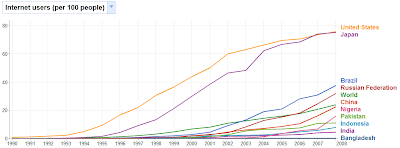The digital divide gap is always trying to be narrowed. The efforts districts, states, and countries have made are not always noticeable. In Maryland, Charles County Public Schools started a program that provided Internet access to all 37 schools in the district. “After professional development training, teachers were able to create lesson plans in hours instead of days, and easily use streaming technology to provide voice, data, and video to the classroom environment” (SETDA,13). Charles County Public Schools are also digitizing all of the core subject areas and mapping it to the state curriculum. When technology is incorporated into the classrooms, teachers are able to create a more flexible lesson plan that accommodates all types of learners. By having a program that gives Internet to all 37 schools in the district, students who do not have access to the Internet in their home are given the opportunity to become familiar with it in school. Although Internet access was given to all 37 schools in the districts, the teachers now have the challenge to learn how to effectively use the Internet in the classroom to benefit their students.
In some school districts, the problem isn't if they can afford Internet or not. In states such as Kentucky, many schools could not have access to the Internet even if they wanted to. Since some locations in Kentucky were not able to have access, they wanted to bring broadband into the entire state. In Kentucky, they have created a partnership to “accelerate the growth of technology in support of community and economic development, improved healthcare, enhanced education, and more effective government” (SETDA, 19). Since the plan has been implemented, an increase of broadband availability by 53% has been seen. Three years ago, only 60% of households could have broadband which has now increased to 95%. “The percentage of citizens using broadband has increased by 100%” (SETDA, 19). Having access to the Internet has improved Internet use by all Kentuckians. Not only has Internet been provided, but approximately 2,000 home computers have been given to students via the "Computers 4 Kids" (for more information, see the video bellow). The Computers 4 Kids partnership was created to help students gain access to a computer in their home. Over $2.2 million have gone to refurbish and distribute computers to middle school students in poor counties in Eastern Kentucky (SETDA, 20). A Kentucky resident and teacher said, “Kids need to have access to learning 24/7 – inside and outside of school. Computers can be used to expand educational opportunities. When kids have computers at home, it allows them to get more practice and learn more experimentally” (SETDA, 20). Kentucky has provided a fantastic model to help narrow the gap of the digital divide.
For more information visit the following links:
Connect Kentucky - Additional information on Kentucky's need to expand broadband across the state and their use of "Computers 4 Kids"
Connect Ohio - Information on Ohio's No Child Left Offline involvement
<-- Previous Next -->

